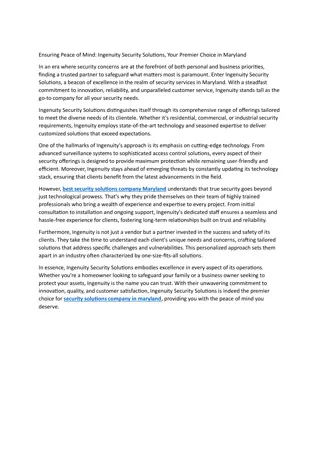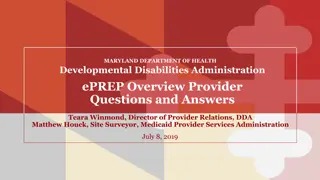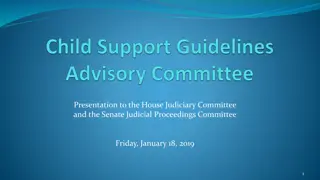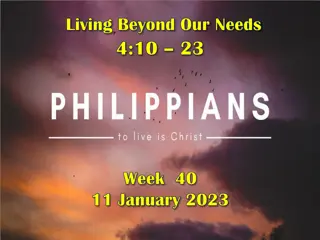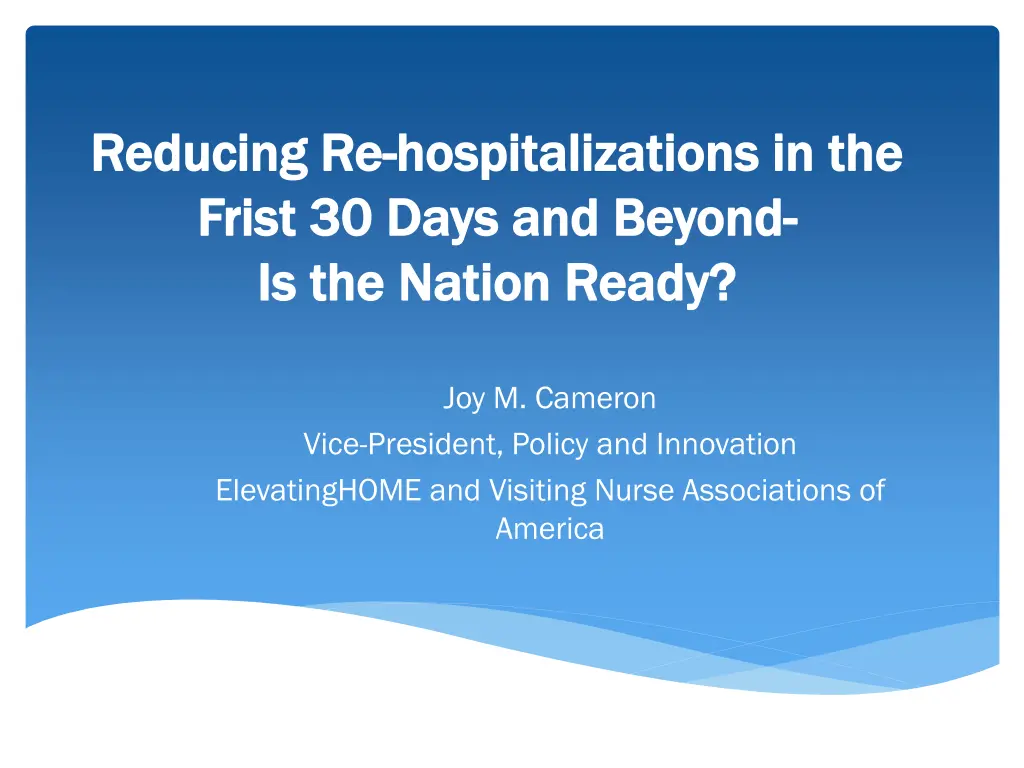
Reducing Re-Hospitalizations in the First 30 Days and Beyond: Is the Nation Ready?
Explore the imperative shift towards home-based care to reduce re-hospitalizations, focusing on high-quality, cost-effective practices. Demographic changes and policy drivers are reshaping healthcare delivery, emphasizing patient preferences and value-based care models.
Download Presentation

Please find below an Image/Link to download the presentation.
The content on the website is provided AS IS for your information and personal use only. It may not be sold, licensed, or shared on other websites without obtaining consent from the author. If you encounter any issues during the download, it is possible that the publisher has removed the file from their server.
You are allowed to download the files provided on this website for personal or commercial use, subject to the condition that they are used lawfully. All files are the property of their respective owners.
The content on the website is provided AS IS for your information and personal use only. It may not be sold, licensed, or shared on other websites without obtaining consent from the author.
E N D
Presentation Transcript
Reducing Re Reducing Re- -hospitalizations in the hospitalizations in the Frist 30 Days and Beyond Frist 30 Days and Beyond- - Is the Nation Ready? Is the Nation Ready? Joy M. Cameron Vice-President, Policy and Innovation ElevatingHOME and Visiting Nurse Associations of America
History of Care The movement from institutional care to home and community based care Drive to home Drive to quality over quantity
Demographic focus Silver Tsunami Growing chronic conditions Demographics of Medicare home health patients Settings of care
High Quality with Cost-effectiveness Successful care transitions Focus on evidence-based practices Team-Based Care Specializations joint replacement recovery, COPD, post-transplant recovery, etc. Falls prevention Medication management Reduction in re-hospitalization
The Imperative for Home-Based Care Demographic shifts Patient preference Alignment with HHS Triple Aim goals Population Health Patient Experience Lower Cost of Care Home health providers can serve homebound patients and many others; those facing an acute exacerbation, with chronic conditions, or that need care coordination services Medicare beneficiaries want to stay home as long as possible, regardless of their homebound status; home health providers can increasingly facilitate this goal Home health services can substitute for higher- cost institutional providers as well as provide the continuing care that prevents hospital and other high- cost utilization Source: The Alliance for Home Health Quality and Innovation
Drivers Emphasizing Home-Based Care POLICY AND CONSUMER PREFERENCE INFLUENCE THE SHIFT Consumer preference for home-based care is consistently shown CMS/CMMI initiatives incentivize the use of home healthcare in Medicare o Emphasis on value creates incentives to utilize less costly home healthcare services where appropriate Payers and providers engaged in alternative payment models are developing emphasis on shifting the site of care towards the home. 6 Source: The Alliance for Home Health Quality and Innovation
External Industry Influences Aging Aging Population Population Exponential Growth Anticipated Individuals receiving long term care services and supports anticipated to increase from 15M in 2013 to 27M in 2050 Prevalence of Chronic Disease Prevalence of Chronic Disease Rapid Advancement of Rapid Advancement of New Care Delivery & New Care Delivery & APMs APMs Home health industry anticipated to grow from $30B to $137B in 2020 Technology & Workforce Technology & Workforce Advances Advances Policy Emphasis on Policy Emphasis on Improved Patient Improved Patient Experience Experience
Medicaid Home Health Opportunities Non-homebound for all ages & functional status Behavioral health Public health / prevention New New Services Dev. disabled Populations High risk pregnant women / newborns Management of HCBS networks PMPM for care coordination; management of HCBS networks; and services Assume responsibility for care coordination across full continuum of care New Payment Arrangements Care Coordination Value-based Purchasing
Readmissions: why? Why the focus on this measure? Cost driver Acceptance of risk Home Health Value Based Purchasing Accountable Care organizations Advanced Payment Models
VBP Growth in Medicare Target % of Medicare FFS payments linked to quality and alternative payment models in 2016 By the end of 2014, CMS reported alternative payment models accounted for 20% of Medicare FFS payments to Alternative Payment Models FFS linked to Quality Medicare FFS 90% 90% 85% 85% 50% 50% 30% 30% 2016 2018 *Alternative Payment Models: ACOs. medical homes, bundled payments, comprehensive primary care initiative, comprehensive ESRD, duals financial alignment FFS Model, Pioneer ACOS years 3-5
Increasing Experience with New Payment Models Growing comfort with Risk Capitation Bundling Value-based Purchasing Payment coordination amongst a variety of payers
Readmissions The role of home based care in the continuum of care The role of readmissions in payment models Flexibility of methods of care
Intersection of Best Practice & Costs Paradigm Shift Required: Move from silo-approach to practice to shared responsibility and accountability What you measure will get managed. Hospital Risk Mgmt Value = Outcomes
Risk vs. Reward Risk models Quality bonus payments Role of contractor vs subcontractor
Interaction of Clinical Decision Making & Costs Patient Satisfaction Paradigm Shift Required: Move from optimizing productivity to measure of clinician success in risk management/(re- )hospitalization reduction APTA Resource: Comprehensive Care Joint Replacement Model Contracting Checklist, March 2016. www.apta.org Quality Outcomes Reduced Costs CMS Triple Aim
Shifting Preferences Leading to Shifting Policies How to meet public demand Commonality of practice in other sectors of care
Barriers to Success Homebound Orders for home health Conceptualization of capabilities State and federal restrictions hindering practice and training
Dont Know What They Dont Know Hospitals are aware of inpatient practices, but lack the knowledge of post-acute providers In earliest conversations, most time was spent educating Conveners/Episode Initiators (EI) on Home Health Billing and practices Erroneous assumptions by Conveners/EIs included believing: # of days impacts total cost HH agencies added nursing for additional revenue Home health aide and social work increase cost LUPAs were best practices
Legislative Options Homebound Orders for home health State and federal restrictions hindering practice and training
Legislative update Legislative Issue Major Provisions ElevatingHOME Actions Allows nurse practitioners, clinical nurse specialists and physician assistants to order home health services under Medicare Home Health Care Planning and Improvement Act (H.R. 1825/S. 445) Actively engaging with E&C, W&M and Finance members to grow sponsorship and push for a hearing, markup, and passage. Positioning legislation to be included in potential end-of-year extenders package. Status: House Cosponsors: 120 (71 D, 49 R) Senate Cosponsors: 38 (27 D, 10 R, 2 I) Establishes Palliative Care and Hospice education centers and fellowship programs to provide training and workforce development in palliative care services. Provides funding for palliative care research. Engaging with committees of jurisdiction (E&C and HELP Committee) to grow sponsorship in Senate and ask for markup in House. Participated as a Group Leader and supported follow-up efforts for the Patient Quality of Life Coalition Virtual Lobby Day & Hill Day in June. Palliative Care and Hospice Education and Training Act (H.R. 1676/S. 693) Status: House Cosponsors: 187 (115 D, 72 R) Senate Cosponsors: 15 (8 D, 6 R, 1 I)
Snapshot: Legislative Action Legislative Issue Major Provisions ElevatingHOME Actions Updates face to face documentation requirements to require that the home health agency s patient record be used as supporting material as appropriate. Establishes a settlement process for appeals of denied claims. Home Health Documentation and Program Improvement Act of 2017 (H.R. 2663) Met with staff from previous Senate sponsors. There is interest in reintroducing. Meeting with W&M and E&C members to build sponsorship. Deploy VNAA & ElevatingHOME members to ask MoCs for support. Positioning to be included in end-of- year extenders package. Status: House Cosponsors: 27 (9 D, 18 R) Collaborating with other Palliative Care and Hospice advocacy groups to strategize best approach to build support for the bills in Congress and to deliver a unified message. Creates a Medicare benefit for those with serious or life-threatening illness that includes team-based discussion of goals of care and values, explanation of disease progression, exploration of a relevant range of treatment options, and documented care values and preferences. Patient Choice and Quality Care Act (H.R. 2797/S. 1334) Status: House Cosponsors: 16 (11 D, 5 R) Senate Cosponsors: 5 (2 D, 3 R) Directs the Center for Medicare and Medicaid Innovation (CMMI) to conduct an Advanced Illness Coordination Services demonstration
Snapshot: Legislative Action Legislative Issue Major Provisions ElevatingHOME Actions Extends the 3 percent rural add-on for Medicare home health services through 2022. Engaging House W&M members to sponsor a companion. Raising the legislation as a priority with W&M and Finance Committees to ensure this get extended. Preserve Access to Medicare Rural Home Health Services Status: Legislation (S. 353) introduced in the Senate by Sen. Susan Collins (R-ME) & Sen. Maria Cantwell (D- WA). Allows for reimbursement of telehealth services for home health agencies participating in ACOs S. 870 - Creating High Quality Results and Outcomes Necessary to Improve Chronic Care Act of 2017 VNAA is advocating for full Medicare reimbursement for telehealth services provided by HHAs, not just those participating in ACOs. Continues to reiterate this message in all meetings with the Senate before full Senate vote is scheduled. Commissions a GAO study and report on longitudinal comprehensive care planning services under Medicare part B.
Snapshot: Legislative Action Legislative Issue Major Provisions ElevatingHOME Actions Legislation introduced in the 114th Congress would have held post-acute care providers to untested IMPACT Act measures at a high percentage of risk. Legislation as introduced was focused solely on cost savings, with little attention paid to quality of care provided. Engaging with other post-acute care provider stakeholders to influence legislation that places equal emphasis on quality that it does cost savings. Post-Acute Care Value-Based Purchasing Status: Legislation is currently being worked on for reintroduction in the House. Very little details are known.

